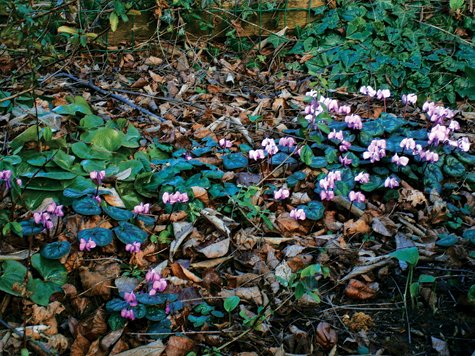GARDENER'S NOTEBOOK

Winter Woodland Darlings
Cyclamens...Harbingers of Spring
By Mariko Kawaguchi
Travel has a way of opening your mind to new experiences, which is a powerful teacher, especially in the plant world.
I recently traveled to England to spend the holiday with relatives, and found that my seasonal plant clock had jumped forward into an early spring. After getting over my initial surprise at the vast amount of plants blooming in England, I quickly came to understand that much of the southern parts of the United Kingdom (including London) have plant hardiness zones of 8 and 9, due to the North Atlantic Current that brings in warmer air from south of the islands. The latitude of cool tolerant plants used in commercial displays and containers was astounding for this time of year.
Geraniums still in bloom, pansies in their prime, heathers, Persian violets, Hebes, jasmine and Daphne, all exploding into color in window boxes, hanging plant baskets and flowering shrubs in the landscape. I found myself walking along the beach in Brighton with just a faint breeze blowing off the English Channel. A few blocks away I encountered the magnificent gardens at the Royal Pavilion, where violets, Bergenia and Bellis were in bloom, while the salt air and waters edge made me feel like I was back home. The headliner of this new found spring was cyclamen. At Kew Gardens, I was delighted to find a large collection of hardy cyclamen for sale in their retail area. I have always loved how hot house cyclamen have managed to escape the commercialization of imprinting as a specific holiday plant. They are the champions of winter windowsills and are suitable for any occasion. Cyclamen are in their prime flowering from December through April.
What's new in the world of floral design and cyclamen? The enterprising Dutch growers, have been cutting the flowers of the plant to sell in the cut flower industry. The many colorful, showy hues complement the compact short Euro style designs, especially focusing on wedding bouquets and other botanical accents,.
The name cyclamen comes from the Greek word "kyklamenos", meaning a "circle form", an apt description of the cyclamen tuber. In the language of flowers, they symbolize departure, and are often given to a person who is retiring or relocating. The flowers of the plant are reflexed, with silver patterned leaves. The indoor variety, sold by florists are known as Cyclamen persicum, and are native to the Mediterranean region and Europe. These plants prefer bright filtered light, with moderate temperatures and high humidity. During the day, they should not be exposed to temperatures over 68 degrees Fahrenheit, and prefer around 50 degrees Fahrenheit at night. Correct watering is essential to the survival of the cyclamen, and care should be given to avoid the extremes of under and over watering. The architecture of the plant with its tight forming stems and leaves create an ideal environment for fungal and bacterial problems if water gets into the core of the tuber. The best method is to water from the bottom of the plant, in a saucer with water filled to capacity. Allow the soil to be saturated for half an hour, and then remove any excess water left in the saucer. Cyclamen should have a potting medium with excellent drainage that holds water well. During this time the plant should be fertilized with a weak solution of water soluble fertilizer. Over feeding is more likely to produce more foliage than flowers. Once the flowers dry out and leaves begin to fall, reduce watering to a minimum. At this dormant state, the plant should be kept in a cool, dark place for a couple of months.
The outdoor variety of cyclamen, Hardy cyclamen ,including the hardiest species of coum, hederifolium and purpurascens, provide a cheerful burst of color to the winter landscape. While these plants are hard to propagate from seed, they can be grown from tubers, planted in late summer or early autumn. The tubers should be planted just below the soil's surface (with the top of the tuber facing up), and allow 6 to 10 inches between each tuber. Hardy cyclamen can tolerate cold climates and freezing winter, although they cannot survive in an environment where the summers are hot and dry. Soil that is loose and well drained works best for the Hardy cyclamen, and be sure to dig a few inches of mulch, compost or other organic matter into the soil before planting. Water the plant regularly during the spring and summer months, but avoid over watering, as the tubers may rot in waterlogged soil. When autumn comes, brush excess leaves and debris from the plant, as too much cover prevents the plants from getting light, (a small layer of mulch or leaves may be utilized, however, to protect the roots from cold). During the latter part of summer, the tubers can be divided, but avoid disturbing older, well established tubers.
Take a visit to the Polly Hill Arboretum (PHA) in winter, and you will quickly spot the Hardy cyclamen growing amongst the brush and fallen leaves in Polly's Playpen. An attentive set of eyes will see the contrast of the mottled foliage peeking out from autumn’s debris. Tim Boland, executive director at PHA describes their collection: "We received our plants in the early 1970’s, four different species that vary in bloom time, from late summer, fall and early winter. They are choice plants that our visitors love, especially small children who marvel at the blooms and late season color. The PHA is growing them from seed for future plant sales. They take three years to grow into a large enough plant to sell, but its worth it!” In stretching the boundaries of plant zone hardiness, Polly's mantra was always “try it, what do have to lose?” With what I saw and learned in England this winter, along with Polly's courage to challenge microclimates, I am going to try planting some mini cyclamen (with hardy strains in their breeding) in large pots in a sheltered area, to try and brighten up an empty, fallow pot, while awaiting spring bulbs in April. I am convinced that the miniature cyclamen sold in our green-houses here on the Vineyard are crossed with a hardy species.
I look forward to stretching my cyclamen wings and seeing how far I can push the plant boundaries. I am keeping my green thumbs crossed. Happy spring wherever you are!
I recently traveled to England to spend the holiday with relatives, and found that my seasonal plant clock had jumped forward into an early spring. After getting over my initial surprise at the vast amount of plants blooming in England, I quickly came to understand that much of the southern parts of the United Kingdom (including London) have plant hardiness zones of 8 and 9, due to the North Atlantic Current that brings in warmer air from south of the islands. The latitude of cool tolerant plants used in commercial displays and containers was astounding for this time of year.
Geraniums still in bloom, pansies in their prime, heathers, Persian violets, Hebes, jasmine and Daphne, all exploding into color in window boxes, hanging plant baskets and flowering shrubs in the landscape. I found myself walking along the beach in Brighton with just a faint breeze blowing off the English Channel. A few blocks away I encountered the magnificent gardens at the Royal Pavilion, where violets, Bergenia and Bellis were in bloom, while the salt air and waters edge made me feel like I was back home. The headliner of this new found spring was cyclamen. At Kew Gardens, I was delighted to find a large collection of hardy cyclamen for sale in their retail area. I have always loved how hot house cyclamen have managed to escape the commercialization of imprinting as a specific holiday plant. They are the champions of winter windowsills and are suitable for any occasion. Cyclamen are in their prime flowering from December through April.
What's new in the world of floral design and cyclamen? The enterprising Dutch growers, have been cutting the flowers of the plant to sell in the cut flower industry. The many colorful, showy hues complement the compact short Euro style designs, especially focusing on wedding bouquets and other botanical accents,.
The name cyclamen comes from the Greek word "kyklamenos", meaning a "circle form", an apt description of the cyclamen tuber. In the language of flowers, they symbolize departure, and are often given to a person who is retiring or relocating. The flowers of the plant are reflexed, with silver patterned leaves. The indoor variety, sold by florists are known as Cyclamen persicum, and are native to the Mediterranean region and Europe. These plants prefer bright filtered light, with moderate temperatures and high humidity. During the day, they should not be exposed to temperatures over 68 degrees Fahrenheit, and prefer around 50 degrees Fahrenheit at night. Correct watering is essential to the survival of the cyclamen, and care should be given to avoid the extremes of under and over watering. The architecture of the plant with its tight forming stems and leaves create an ideal environment for fungal and bacterial problems if water gets into the core of the tuber. The best method is to water from the bottom of the plant, in a saucer with water filled to capacity. Allow the soil to be saturated for half an hour, and then remove any excess water left in the saucer. Cyclamen should have a potting medium with excellent drainage that holds water well. During this time the plant should be fertilized with a weak solution of water soluble fertilizer. Over feeding is more likely to produce more foliage than flowers. Once the flowers dry out and leaves begin to fall, reduce watering to a minimum. At this dormant state, the plant should be kept in a cool, dark place for a couple of months.
The outdoor variety of cyclamen, Hardy cyclamen ,including the hardiest species of coum, hederifolium and purpurascens, provide a cheerful burst of color to the winter landscape. While these plants are hard to propagate from seed, they can be grown from tubers, planted in late summer or early autumn. The tubers should be planted just below the soil's surface (with the top of the tuber facing up), and allow 6 to 10 inches between each tuber. Hardy cyclamen can tolerate cold climates and freezing winter, although they cannot survive in an environment where the summers are hot and dry. Soil that is loose and well drained works best for the Hardy cyclamen, and be sure to dig a few inches of mulch, compost or other organic matter into the soil before planting. Water the plant regularly during the spring and summer months, but avoid over watering, as the tubers may rot in waterlogged soil. When autumn comes, brush excess leaves and debris from the plant, as too much cover prevents the plants from getting light, (a small layer of mulch or leaves may be utilized, however, to protect the roots from cold). During the latter part of summer, the tubers can be divided, but avoid disturbing older, well established tubers.
Take a visit to the Polly Hill Arboretum (PHA) in winter, and you will quickly spot the Hardy cyclamen growing amongst the brush and fallen leaves in Polly's Playpen. An attentive set of eyes will see the contrast of the mottled foliage peeking out from autumn’s debris. Tim Boland, executive director at PHA describes their collection: "We received our plants in the early 1970’s, four different species that vary in bloom time, from late summer, fall and early winter. They are choice plants that our visitors love, especially small children who marvel at the blooms and late season color. The PHA is growing them from seed for future plant sales. They take three years to grow into a large enough plant to sell, but its worth it!” In stretching the boundaries of plant zone hardiness, Polly's mantra was always “try it, what do have to lose?” With what I saw and learned in England this winter, along with Polly's courage to challenge microclimates, I am going to try planting some mini cyclamen (with hardy strains in their breeding) in large pots in a sheltered area, to try and brighten up an empty, fallow pot, while awaiting spring bulbs in April. I am convinced that the miniature cyclamen sold in our green-houses here on the Vineyard are crossed with a hardy species.
I look forward to stretching my cyclamen wings and seeing how far I can push the plant boundaries. I am keeping my green thumbs crossed. Happy spring wherever you are!








